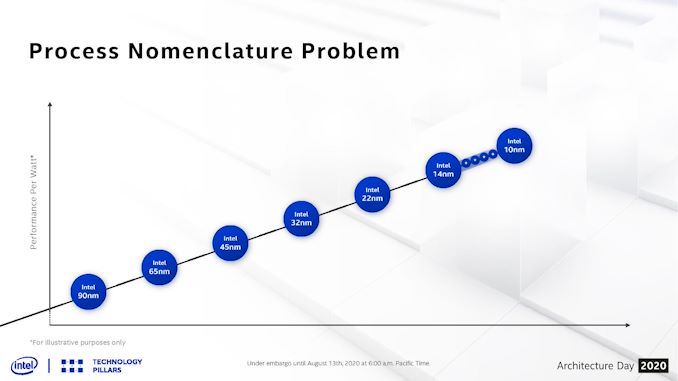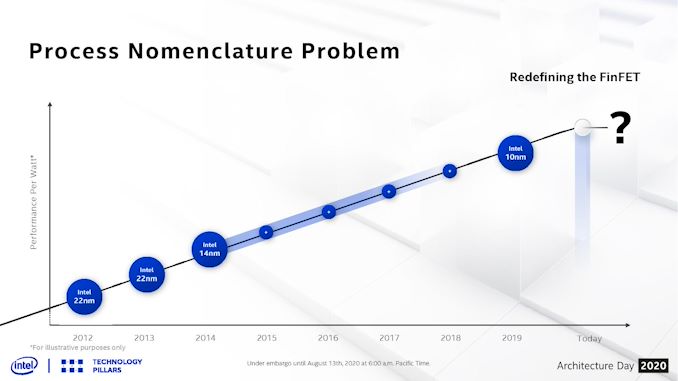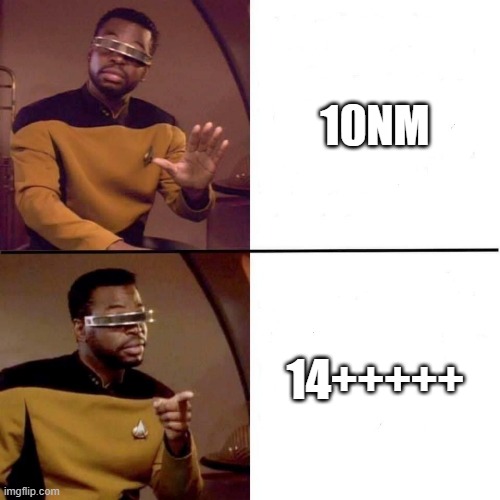What Products Use Intel 10nm? SuperFin and 10++ Demystified
by Dr. Ian Cutress on September 25, 2020 9:00 AM EST_678x452.jpg)
For our audience that regularly keeps track of Intel’s product portfolio, it would be hard to miss that the naming strategy of Intel’s process node technologies is a bit of a mess. To some, those words are themselves an understatement, as Intel has shifted its naming strategy 2-3 times since the launch of Intel’s first 10nm products. Not only that, even Intel’s various departments internally have a hard time keeping track of ‘what is this manufacturing process being called today’ when the press like AnandTech ask for details on the latest upcoming products.
Knowing this, and knowing what issues Intel has been having, I wanted to demystify Intel’s manufacturing process naming scheme such that users and engineers alike, even if they are inside Intel, can understand what is what but also importantly why. The why is the crucial factor.
If you're looking for a handy decoder ring for Intel's 10nm Products, it's here in page 3.
Why Do We Have Multiple Versions of a Process?
With Intel’s 14nm, we were invited to 14nm, 14+, 14++, 14+++, and if you believe Intel’s own slides, there were variants that went beyond this ++++ naming scheme. Each one of those additional + points on the end of the name signified a change in the process technology – usually to assist for increasing performance or efficiency.
Each one of these + points is an update to the BKM, or Best Known Methods.
While an engineer can draw an electrical layouts for a part of a processor, such as an addition circuit, actually applying that design to a silicon floorplan for manufacturing is a different skill altogether. Transistor libraries are designed to take advantage of a given process, and when a floorplan is optimized for a process, it can then be pasted and repeated as necessary – on top of this, simulation on thermals, power, and current density are applied to ensure that there are no hotspots or that critical paths inside the design have as few bottlenecks as possible.
When an update to the BKM occurs, two things can happen. Normally we see the update on the level of the transistor library that is changed – if the distance between two fins on a transistor increases for example, the transistor library and the macros may be made bigger, and then the floorplan might be redesigned to take account for this. As for any process node design, there are 100 different controls, and improving one might make three other controls worse, so it is a fine balancing act. Not only this, but the BKM has to be validated at the manufacturing level. The BKM update could apply to the metal stack as well, which in of itself can adjust the performance.
In the long long past, BKM updates were never advertised externally. If Intel or TSMC or another foundry discovered a way to improve the performance, or decrease the voltage, or improve the yield, the update was silently rolled into the design and nothing much was made of it. Sometimes processors would be listed as ‘1.0 volts to 1.35 volts’, and it would just be a roll of the dice if a user obtained one of the lower voltage models.
However, as time between different process node updates has elongated, these BKM updates have started to be identified and effectively monetized by the semiconductor companies. An update to a process that improves the voltage by 50 millivolts and increases frequency by 200 MHz immediately becomes a productizable event, and products built on these updates can be offered for more money over the usual. Or, depending on the rate of updates, the whole next generation of products could be built on the update.
So we never saw BKM updates officially announced at Intel’s 45nm, 32nm, or 22nm process nodes. These updates were fast enough that the productization of any update didn’t warrant a full round of marketing. With 14nm, that changed.
Intel had discussed its roadmap beyond 14nm since its 2010 Investor Meeting. It predicted that the company would be on 14nm by 2013, 10nm by 2015, and 7nm by 2017. As we now know, 14nm was two years late, and 10nm was 2-4 years late. Because of the introduction of 10nm being delayed, Intel decided to productize its 14nm BKM updates, and signified those with + points.
Intel’s current official line is that there have been four updates to 14nm, creating five ‘generations’.
More Plus Means More Meme
Because of all the + points, Intel’s marketing sometimes getting it wrong, and perhaps a little bit of ‘++’ in most programming languages meaning ‘+1’, the whole concept of adding + to the process node has become a meme – a meme at Intel’s expense, purely on the basis of its failure to deliver 10nm before the 14++++ naming scheme got out of hand.














143 Comments
View All Comments
rbarone69 - Sunday, September 27, 2020 - link
hahaha I thought the very exact same thing!MrSpadge - Friday, September 25, 2020 - link
Not sure, but I have a slight suspicion you may be joking here...Spunjji - Monday, September 28, 2020 - link
It's kind of agonising that people keep writing serious responses to this comment section's most obvious troll.supdawgwtfd - Monday, October 12, 2020 - link
Why do you think he is still here?He gets hits. Hits means and revenue. Which of course means money.
Anandtech's owners love him.
Samus - Saturday, September 26, 2020 - link
You'd be crazy to think either of these companies (AMD or Intel) will exist in their current forms in just a few years. x86 needs to die. Any legacy requirements can be appropriately emulated using virtual machines or code morphing on alternative architectures.The disturbing part is AMD and Intel are seemingly in denial over this because neither have any ARM or alternative IP-designs in their pipeline for the next 5 years. Seriously in 5 years ARM will have 50% of the market and you can bet that'll shift other consumer segments currently dominated by x86 (such as game consoles)
Showtime - Saturday, September 26, 2020 - link
Emulators aren't the most efficient way of doing things, but it's hard to deny where computing seems to be heading. Neither will abandon it until they have to, and even then there will be a market to support x86 for decades after.Spunjji - Monday, September 28, 2020 - link
What form do you think they'll exist in, and why?What's your reason for predicting a 50% shift to ARM, and in which market?
mdriftmeyer - Tuesday, September 29, 2020 - link
ARM will be the Albatross around Nvidia's throat.grant3 - Friday, October 2, 2020 - link
"x86 needs to die." Why?Serious question. I've been hearing this same line for over 20 years.
But still haven't heard any reason that actually solves a practical problem.
It's always some variant of "it's old" "it requires legacy support" "intel is evil" "RISC is faster" yadda yadda. Basically it's complaining about imaginary problems that engineers have mitigated into oblivion years ago, or an idealogical conviction that immature/imaginary technologies will magically avoid the compromise and tradeoffs that every mature technology has endured.
"ARM will have 50% of the market"
50% of which market? There's already billions of ARM devices out there in the wild. they're wildly popular. I wouldn't be surprised if there's more ARM cpus active in the world than there are x86 cpus active in the world.
ARM is proving itself successful, x86 is remaining popular, and technology solutions are better than ever despite (or because of) this current coexistence.
"Any legacy requirements can be appropriately emulated using virtual machines or code morphing on alternative architectures."
This has been the mating call of x86 replacement advocates for decades, including the inventor of x86 itself back in the 90s, and none of them proved economical. So while you may be right this time, I'm not going to bet on you being more prescient than the thousands of engineers who were funded by billions of dollar across numerous projects in the past.
Whenever x86 sunsets, whatever new software is written at the time will coincidentally be written to support its replacement architecture.
throAU - Monday, September 28, 2020 - link
Nah, ARM is coming. Apple are leading the way but the others will jump ship pretty rapidly when it is shown that no, you don't need to pay both the x86 monetary and technical debt tax to be competitive.